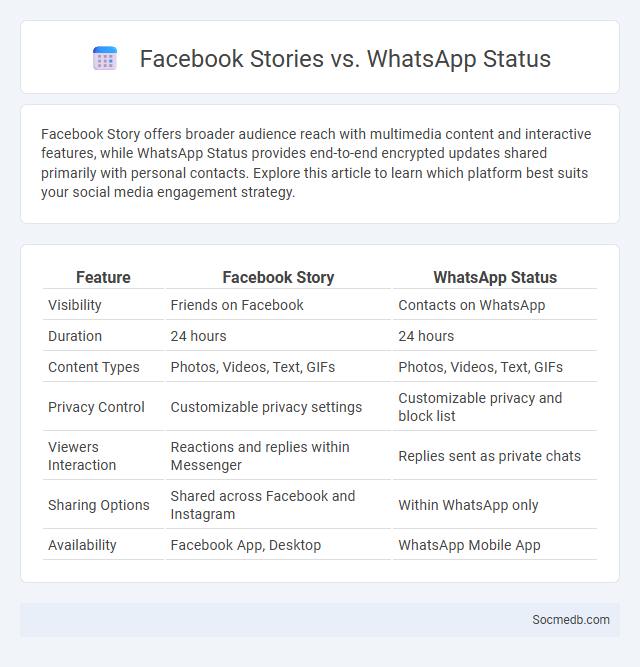
Photo illustration: Facebook Story vs WhatsApp Status
Facebook Story offers broader audience reach with multimedia content and interactive features, while WhatsApp Status provides end-to-end encrypted updates shared primarily with personal contacts. Explore this article to learn which platform best suits your social media engagement strategy.
Table of Comparison
| Feature | Facebook Story | WhatsApp Status |
|---|---|---|
| Visibility | Friends on Facebook | Contacts on WhatsApp |
| Duration | 24 hours | 24 hours |
| Content Types | Photos, Videos, Text, GIFs | Photos, Videos, Text, GIFs |
| Privacy Control | Customizable privacy settings | Customizable privacy and block list |
| Viewers Interaction | Reactions and replies within Messenger | Replies sent as private chats |
| Sharing Options | Shared across Facebook and Instagram | Within WhatsApp only |
| Availability | Facebook App, Desktop | WhatsApp Mobile App |
Introduction: Understanding Social Media Stories
Social media stories offer a dynamic way to share moments that vanish after 24 hours, creating an engaging and immersive user experience. Platforms such as Instagram, Facebook, and Snapchat have popularized this format, enabling brands and individuals to connect with audiences in real time. Your ability to master social media stories can significantly boost interaction and brand visibility across multiple channels.
What is Facebook Story?
Facebook Story is a feature allowing users to share photos and videos that disappear after 24 hours, creating a sense of immediacy and engagement. Your stories can be enhanced with stickers, text, and filters, making your content more interactive and personalized. This tool increases visibility and connection with your audience by showcasing moments in a temporary, yet impactful way.
What is WhatsApp Status?
WhatsApp Status is a feature within the WhatsApp messaging app that allows users to share text, photos, videos, and GIF updates with their contacts for 24 hours. These status updates are end-to-end encrypted, ensuring privacy and security while enabling users to express moments, thoughts, or promotions visually and textually. With over 2 billion active WhatsApp users globally, the Status feature serves as a popular way for personal communication and brand engagement.
Defining 'Story' Feature Across Platforms
The 'Story' feature across social media platforms allows users to share ephemeral content that lasts typically 24 hours, enhancing real-time engagement and authentic communication. Platforms like Instagram, Facebook, Snapchat, and LinkedIn have integrated Stories to offer temporary, visually-rich updates through photos, videos, or text overlays that prioritize immediacy and conversational interaction. Your use of Stories can boost visibility and foster closer connections by leveraging this dynamic format tailored for timely storytelling and user interaction.
Key Differences: Facebook Story vs WhatsApp Status
Facebook Story and WhatsApp Status differ in audience reach and content duration; Facebook Stories are visible to a broader network, including public followers, while WhatsApp Status updates are limited to your contacts only. Both features disappear after 24 hours, but Facebook offers more interactive tools like stickers and polls, enhancing engagement. Choosing between them depends on whether you want to share personal moments with close contacts on WhatsApp or reach a wider social media audience via Facebook.
Audience and Privacy Controls
Social media platforms prioritize audience targeting and privacy controls to enhance user experience and safety. Advanced settings enable users to customize who can view their content, ranging from public visibility to private groups or specific contacts. Robust privacy controls also include options for managing data sharing, blocking unwanted interactions, and controlling profile information accessibility, ensuring personalized security measures.
Content Creation and Editing Tools
Content creation and editing tools are essential for enhancing your social media presence by providing advanced features such as video trimming, filter application, and graphic design templates. Platforms like Canva, Adobe Premiere Pro, and InShot offer intuitive interfaces that streamline the production of visually engaging posts and stories. Utilizing these tools boosts engagement metrics by ensuring Your content is polished, cohesive, and tailored to platform-specific formats.
Engagement, Reach, and Analytics Comparison
Social media engagement, including likes, comments, and shares, directly impacts brand visibility and audience connection. Reach measures the total number of unique users exposed to content, highlighting campaign effectiveness across platforms like Facebook, Instagram, and Twitter. Analytics comparison tools enable marketers to track key performance indicators (KPIs) such as engagement rate, reach growth, and conversion metrics, facilitating data-driven strategy optimization.
Pros and Cons of Each Story Feature
Instagram Stories offer a dynamic way to engage audiences with ephemeral, high-visibility content, boosting brand awareness and real-time interaction through features like polls and swipe-ups, but they risk fleeting impressions and limited content shelf life. Snapchat Stories excel in fostering authentic, casual communication with disappearing content that encourages frequent user engagement yet may suffer from reduced reach and difficulty in content repurposing. Facebook Stories leverage vast user bases and cross-platform sharing to enhance exposure but often face lower organic reach and competition with traditional posts for user attention.
Which Story Platform Should You Use?
Choosing the right social media story platform depends on your target audience and content goals. Instagram Stories offer a vast, engaged user base ideal for visual and interactive content, while Snapchat appeals to younger demographics with ephemeral, playful features. Facebook Stories provide strong integration with existing networks, making them suitable for brands aiming to boost engagement within established communities.
 socmedb.com
socmedb.com